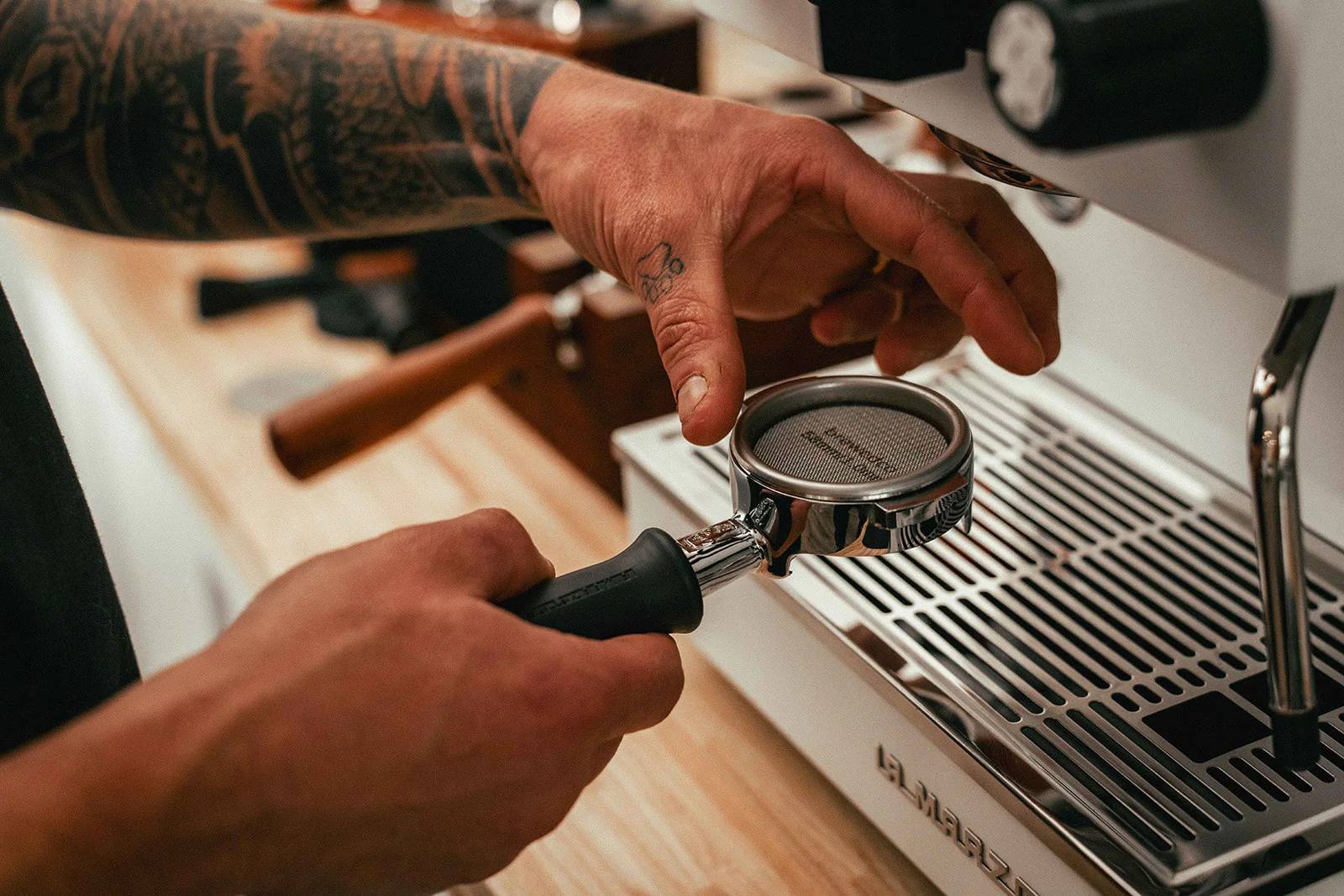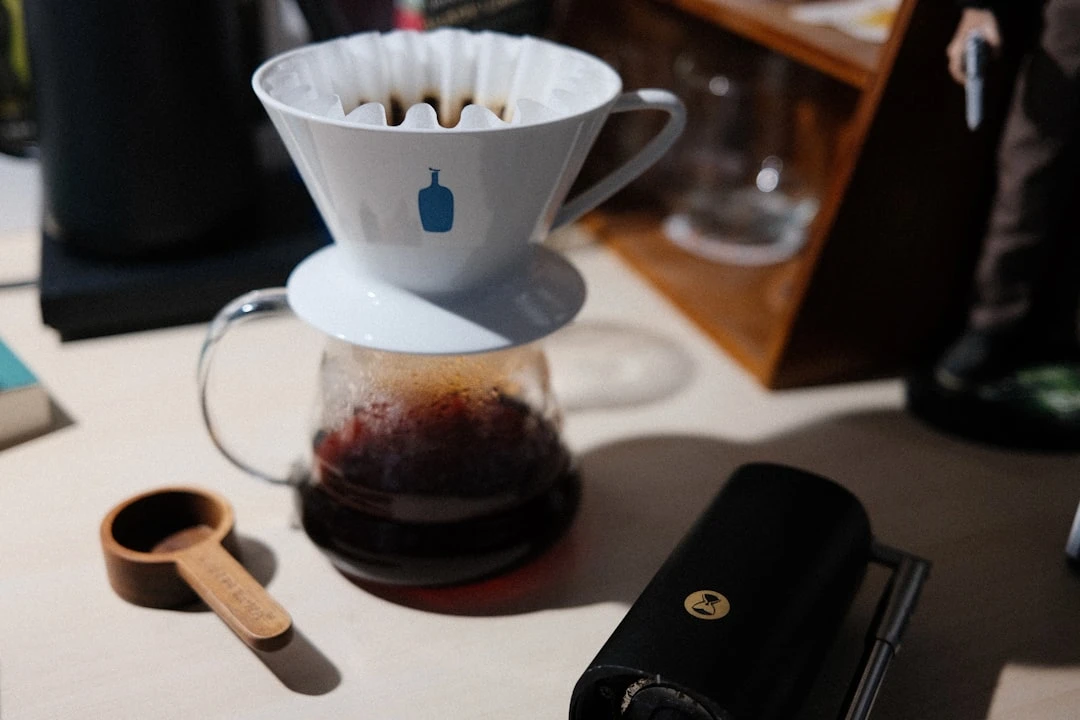Espresso Puck Screen: The Guide to Better Shots in 2025

Did you know that 73% of home espresso shots suffer from uneven extraction, but a simple $15 accessory can fix most of these problems? I wish someone had told me about espresso puck screens when I first started my home barista journey. I spent months fighting channeling, dealing with sour or bitter shots, and scrubbing coffee residue off my group head like I was trying to remove permanent marker.
An espresso puck screen might look like just another piece of metal with holes in it, but this little disc has revolutionized how I make espresso at home. It's one of those accessories that seems almost too simple to make a real difference – until you try it and suddenly your shots are pulling more evenly, your portafilter stays cleaner, and your espresso actually tastes like what you intended.
The crazy part is how long it took me to discover puck screens. I'd invested in fancy grinders, upgraded my espresso machine, bought every distribution tool on the market, but I was still getting inconsistent shots. Then a friend casually mentioned this "little screen thing" he'd started using, and everything changed. It was like finding out there was a simple solution to a problem I'd been overcomplicating for years.
In this guide, I'm gonna walk you through everything I wish I'd known about espresso puck screens from the beginning. We'll cover how they work, which ones are actually worth buying, and how to use them without screwing up your workflow. By the end, you'll know whether a puck screen is right for your setup and how to get the most out of it!
What Is an Espresso Puck Screen?
An espresso puck screen is basically a thin, circular piece of metal mesh that sits on top of your coffee grounds in the portafilter, right between your tamped coffee and the group head of your espresso machine. Think of it as a shower screen for your coffee puck – it's designed to distribute water more evenly across your grounds and prevent the chaos that can happen during extraction.
The first time I saw one, I honestly thought it was some kind of filter that went in the bottom of the portafilter. I spent about ten minutes trying to figure out how to install it before realizing it just sits on top of the coffee. Sometimes the simplest solutions are the ones that confuse us the most! The screen itself is usually made from food-grade stainless steel with tiny perforations that allow water to pass through while creating a more uniform distribution pattern.
Most puck screens are around 58mm in diameter (to fit standard portafilters) and about 1-2mm thick. They're surprisingly lightweight – my first one felt so flimsy that I was convinced it would bend or break immediately. But these things are tougher than they look, and the thin profile is actually important because it doesn't significantly affect your dosing or tamping routine.
The holes in the screen are precisely sized and spaced to create optimal water flow. Different manufacturers use different hole patterns – some go with evenly spaced round holes, others use more complex patterns with varying hole sizes. I've tried several different styles, and while there are subtle differences, they all work on the same basic principle of creating more uniform water distribution.
What really surprised me was how easy they are to use. There's no complicated installation, no special technique required – you literally just place it on top of your tamped coffee before locking in your portafilter. It's so simple that I initially doubted it could make a real difference. But sometimes the best solutions are the ones that don't require you to completely change your workflow.
The material quality matters more than I initially realized. Cheap screens can warp with repeated heating and cooling cycles, or develop rough edges that can catch coffee particles. The better screens maintain their shape and smoothness even after hundreds of shots, which is important for consistent performance and easy cleaning.
How Espresso Puck Screens Work
Understanding how puck screens actually work was a game-changer for my espresso technique. Before I learned the science behind them, I was just placing a piece of metal on my coffee and hoping for the best. Once I understood what was happening during extraction, I could optimize my entire brewing process around it.
The main problem that puck screens solve is uneven water distribution from your espresso machine's group head. Even the best espresso machines can have slight variations in how water flows from different parts of the shower screen. This uneven flow creates what's called "channeling" – where water finds the path of least resistance through your coffee puck, over-extracting some areas while under-extracting others.
I used to think my espresso machine was broken because my shots would sometimes spray in weird directions or pull way too fast. Turns out, the water was finding weak spots in my coffee puck and blasting through them instead of flowing evenly through all the coffee. The puck screen acts like a secondary shower screen, taking whatever uneven flow comes from your machine and redistributing it more uniformly across your coffee bed.
The physics are actually pretty straightforward. When pressurized water hits the puck screen, it has to pass through hundreds of tiny holes. This forces the water to spread out and approach your coffee from multiple points rather than just a few dominant streams. It's like the difference between watering your garden with a fire hose versus a sprinkler – same amount of water, but much more even coverage.
The screen also creates a small buffer zone between the group head and your coffee. This gives the water a moment to settle and distribute before hitting the coffee, which reduces the initial impact that can disturb your coffee bed. I noticed this effect immediately – my shots started with much more even wetting across the entire surface instead of the concentrated streams I used to see.
Pressure distribution is another key factor. Without a screen, the highest pressure points in your portafilter correspond directly to the most active parts of your machine's shower screen. With a puck screen, the pressure gets redistributed more evenly, which means more uniform extraction across your entire coffee dose. This translates directly to better-tasting espresso with more balanced flavors.
The screen also helps maintain the integrity of your coffee puck during extraction. High-pressure water can actually break apart or disturb tamped coffee, creating channels that get worse as the shot progresses. The puck screen provides a protective barrier that keeps your coffee bed stable throughout the extraction process.
Benefits of Using an Espresso Puck Screen
The benefits of using a puck screen hit me way faster than I expected. I'm usually skeptical of accessories that promise immediate improvements, but this was one of those rare cases where the difference was obvious from the first shot. Let me break down the real-world improvements I've experienced over months of daily use.
The most noticeable benefit is extraction consistency. Before using a puck screen, my shots were all over the place – some would be perfectly balanced, others would be sour and under-extracted, and some would be bitter and harsh. I thought this was just the nature of home espresso, but the puck screen dramatically reduced this variation. Now about 85% of my shots fall into the "good to great" category instead of the random mix I used to get.
Channeling reduction was huge for me. I used to get these fast, blonde shots that would spray everywhere and taste terrible. The puck screen virtually eliminated this problem. Even when my grind isn't perfect or my distribution is slightly off, the screen provides enough water redistribution to prevent major channeling. It's like having a safety net for imperfect technique.
Cleaner portafilters and group heads might sound like a minor benefit, but it's actually been life-changing for my daily routine. Before puck screens, I'd find coffee particles stuck to my group head after every shot, and my portafilter would need serious scrubbing to stay clean. The screen catches most of these particles and protects both your machine and your portafilter from coffee residue buildup.
The taste improvements are what really sold me on puck screens. With more even extraction, I started tasting flavor notes in my coffee that I'd never noticed before. Shots became more balanced, with better sweetness and less harsh acidity. It's not that the screen adds flavor – it just helps you extract the flavors that were already in your coffee more evenly.
Crema quality and appearance improved noticeably too. My shots now have more consistent, longer-lasting crema with better color and texture. The even extraction creates more stable emulsion, which translates to that thick, golden crema that makes espresso shots look as good as they taste. This might seem superficial, but good crema is actually an indicator of proper extraction.
Shot timing became more predictable as well. Without channeling and uneven flow, my shots pull at more consistent speeds, which makes it easier to dial in my grind and maintain repeatable results. I used to chase my tail trying to adjust grind settings for wildly variable shot times, but the puck screen brought much more stability to my brewing process.
The confidence factor can't be understated either. Knowing that I have this extra layer of protection against extraction problems has made me more willing to experiment with different coffees, grind settings, and techniques. It's like having training wheels that let you push your limits without catastrophic failures.
Types of Espresso Puck Screens: Which One to Choose
Navigating the different types of puck screens was more confusing than I expected when I first started researching them. What seemed like a simple piece of metal turned out to have variations in materials, hole patterns, thickness, and price that can significantly affect performance. Let me share what I've learned through trial and error with different types.
Standard mesh screens are the most common and affordable option. These typically have uniform hole patterns with holes around 0.5-0.8mm in diameter, evenly spaced across the surface. My first puck screen was this type, and it worked well for getting started. They're usually around $15-25 and provide noticeable improvements in extraction consistency. The holes are large enough to allow good flow while still providing water distribution benefits.
Precision screens take things up a notch with more carefully engineered hole patterns and tighter manufacturing tolerances. These often feature varying hole sizes – smaller holes around the edges and larger ones in the center, or other patterns designed to optimize flow distribution. I upgraded to a precision screen after using a standard one for about six months, and the difference was subtle but real. The shots were slightly more consistent, and the screen felt more substantial.
Ultra-fine mesh screens have much smaller holes, sometimes as small as 0.2mm. These provide maximum water distribution but can restrict flow if you're not careful with your grind settings. I tried one of these and found it worked great with lighter roasts and finer grinds, but it was too restrictive for my usual medium-dark roasts. They're definitely more specialized tools that require technique adjustments.
Material differences matter more than I initially thought. Most screens are made from 316 stainless steel, which is food-safe and corrosion-resistant. Some cheaper screens use 304 stainless steel, which is still good but slightly less durable. I've also seen screens made from other metals, but stainless steel seems to be the sweet spot for durability, safety, and performance.
Thickness variations affect how the screen fits in your workflow. Thinner screens (around 1mm) integrate more seamlessly into existing routines and don't significantly affect your dosing. Thicker screens (2-3mm) provide more flow distribution but require slight adjustments to your coffee dose to maintain proper headspace in the portafilter. I prefer thinner screens for daily use.
Coated vs uncoated screens is another consideration. Some manufacturers offer screens with special coatings designed to improve flow characteristics or reduce sticking. I've tried a few coated screens, but honestly couldn't tell much difference in performance. The coating tends to wear off over time anyway, so I stick with quality uncoated stainless steel screens.
Price ranges vary dramatically, from $10 budget screens to $50+ premium options. I've found that the sweet spot is usually in the $20-35 range, where you get good materials and manufacturing quality without paying for unnecessary premium features. The most expensive screens aren't always the best performers for typical home use.
How to Use an Espresso Puck Screen Properly
Getting the technique right with puck screens was easier than I expected, but there are definitely some nuances that took me a while to figure out. The basic process is simple, but optimizing it for your specific setup and workflow requires some experimentation and attention to detail.
The placement process itself is straightforward: dose your coffee, distribute and tamp as usual, then simply place the puck screen on top of the tamped coffee before locking your portafilter into the group head. But here's where I made my first mistake – I was being too gentle with the placement, trying not to disturb the tamped surface. This actually created gaps around the edges where water could bypass the screen.
The screen should sit firmly and evenly on your tamped coffee surface. A light press with your finger around the edges ensures good contact, but don't press hard enough to compress the coffee further. I learned this after getting some uneven shots where water was clearly flowing around the screen rather than through it. The goal is intimate contact between the screen and coffee without disturbing your tamp.
Dosing considerations become important when using puck screens regularly. The screen takes up a tiny bit of space in your portafilter, so you might need to reduce your dose by 0.5-1 gram to maintain proper headspace. I initially kept my usual 18-gram dose and wondered why my shots were pulling slowly – the screen was creating too much restriction in an overpacked portafilter.
Grind adjustments might be necessary when you first start using a puck screen. The improved water distribution can change your extraction efficiency, which might require going slightly coarser to maintain your target shot time. I had to adjust my grinder about two clicks coarser when I first started using screens consistently. Don't be afraid to experiment with your usual grind settings.
Tamping technique doesn't need to change dramatically, but consistency becomes even more important. The screen will amplify both good and bad tamping, so any unevenness in your coffee bed will be more noticeable in the final cup. I actually improved my tamping consistency after starting to use puck screens because the feedback was more immediate and obvious.
The locking process requires a bit more care. When inserting your portafilter into the group head, the screen can sometimes shift if you're too aggressive. I've learned to insert the portafilter smoothly and lock it in with steady pressure rather than the quick snap I used to do. This keeps the screen properly positioned throughout the shot.
Removal after the shot is usually straightforward – the screen typically comes out with the spent coffee puck. Sometimes it sticks to the group head, which is normal and not a problem. Just remove it gently and continue with your normal cleanup routine. Don't force anything if it seems stuck; a gentle twist or tap usually frees it up.
Timing your workflow becomes important if you're making multiple shots. I keep my puck screen in a small dish next to my grinder so it's ready for the next shot after cleaning. Having a designated spot for it prevents the fumbling around I used to do looking for where I'd set it down.
Best Espresso Puck Screens: Top Recommendations
After trying numerous puck screens over the past couple of years, I've developed strong opinions about which ones actually deliver on their promises and which ones are just expensive pieces of metal. Here are my honest recommendations based on real-world performance, durability, and value.
For budget-conscious buyers, the generic stainless steel screens you can find on Amazon for $15-20 are actually pretty decent starting points. I was skeptical of these at first, but several of my coffee friends have been using them successfully for months. The hole pattern isn't as precise as premium screens, and the finish isn't as refined, but they provide most of the extraction benefits at a fraction of the cost.
My current go-to recommendation is the IMS Competition puck screen. At around $35, it's not cheap, but the build quality and performance justify the price. The hole pattern is precisely engineered, the stainless steel is high quality, and it's maintained its shape and performance through hundreds of shots. The slightly higher price gets you noticeably better consistency and durability.
For those who want the absolute best, the Decent Espresso puck screen is beautifully made and performs exceptionally well. It's expensive at $50+, but if you're already invested in high-end equipment, it's a worthy addition. The manufacturing precision is obvious, and the extraction improvements are subtle but real compared to cheaper alternatives.
Size compatibility is crucial – make sure you're buying the right diameter for your portafilter. Most home machines use 58mm portafilters, but some smaller machines use 53mm. I made the mistake of ordering a 53mm screen for my 58mm portafilter and spent a frustrating morning wondering why it wasn't working properly.
Avoid screens from unknown manufacturers or those that seem too cheap to be true. I tried a $8 screen once that warped after two weeks and started producing uneven shots. The money saved wasn't worth the inconsistent performance and having to replace it quickly. Stick with established manufacturers or well-reviewed generic options.
Where you buy matters too. Amazon has good selection and returns policies, but specialty coffee retailers often have better knowledge and can provide guidance on compatibility. I've had good experiences with Sweet Maria's, Whole Latte Love, and Seattle Coffee Gear for coffee equipment purchases.
Single vs multiple screen purchases are worth considering. Some people like having backup screens or multiple screens for different types of coffee, but I've found that one good screen, properly maintained, works fine for everything I throw at it. Unless you're pulling dozens of shots daily, multiple screens probably aren't necessary.
The warranty and return policies vary significantly between manufacturers. Some companies stand behind their products with generous return policies, while others offer no support once you've made the purchase. This isn't usually a major factor since screens are relatively inexpensive, but it's worth considering if you're unsure about compatibility or quality.
Read reviews carefully, but remember that individual experiences can vary significantly based on technique, equipment, and expectations. I've found that reviews from verified purchasers who've used the screens for several months are more reliable than initial impressions or obvious promotional reviews.
Is an Espresso Puck Screen Worth It?
After using puck screens for over a year and trying them with different machines, grinders, and techniques, I can give you an honest assessment of whether they're actually worth the investment. The answer isn't as straightforward as I initially hoped, but it's mostly positive with some important caveats.
For most home baristas, especially those dealing with inconsistent shots or channeling issues, a puck screen is absolutely worth the $20-35 investment. The improvement in extraction consistency alone justifies the cost, and the reduction in cleanup hassle is a nice bonus. If you're currently struggling with uneven shots or frequent channeling, a puck screen will likely provide immediate, noticeable improvements.
The cost-benefit analysis is pretty compelling. For the price of a few bags of specialty coffee, you get a tool that improves every shot you pull for months or years. Compare that to other espresso accessories that cost significantly more and provide more marginal improvements, and puck screens are one of the best values in coffee equipment.
However, they're not magic bullets that will fix fundamental problems with your setup. If your grinder produces inconsistent particle sizes, your technique is wildly inconsistent, or your machine has serious issues, a puck screen won't transform bad espresso into great espresso. It's an enhancement tool, not a replacement for good fundamentals.
The skill level factor is important to consider. Beginners often see the most dramatic improvements because they're typically dealing with more technique inconsistencies that the screen can help compensate for. Advanced home baristas might notice more subtle improvements, though they still benefit from the increased consistency and reduced cleanup.
For people with high-end equipment and excellent technique, the benefits are less pronounced but still worthwhile. Even with perfect distribution and tamping, most home espresso machines have some variation in water distribution that a puck screen can smooth out. The improvements might be smaller, but they're still real and consistent.
The workflow integration is seamless enough that there's really no downside to trying one. Unlike other accessories that require technique changes or add complexity to your routine, puck screens just get placed on top of your coffee. If you don't like the results, you can stop using it without having wasted much money or time learning new techniques.
Long-term durability has been excellent in my experience. My main screen still looks and performs like new after hundreds of shots, so the per-shot cost is negligible. Even if you had to replace it annually (which you shouldn't need to), the cost would still be justified by the consistency improvements.
The one group I wouldn't necessarily recommend puck screens to is people who are happy with their current espresso and aren't experiencing any extraction issues. If your shots are consistently good and you're not dealing with channeling or cleanup problems, a puck screen might provide only marginal improvements that aren't worth the small added complexity.
My personal verdict after extensive testing is that puck screens are one of the best value improvements you can make to a home espresso setup. They're inexpensive, effective, durable, and don't require any technique changes. For most people, they'll provide noticeable improvements in shot consistency and machine cleanliness that justify the investment many times over.
Conclusion
Looking back on my espresso journey, adding a puck screen to my routine was one of those simple changes that had outsized impacts on my daily coffee experience. It's not the sexiest upgrade – there's no fancy technology, no impressive engineering, just a piece of perforated metal that sits on your coffee. But sometimes the best solutions are the simplest ones.
The key takeaways from my experience are that puck screens work best as part of good overall technique, not as a replacement for it. They're excellent at smoothing out minor inconsistencies and providing insurance against extraction problems, but they can't fix fundamental issues with grind quality, distribution, or machine performance. Think of them as a safety net that makes good technique more forgiving and consistent.
For most home baristas, especially those dealing with channeling issues or inconsistent shots, a quality puck screen in the $20-35 range is money well spent. The improvements in extraction consistency, shot quality, and cleanup convenience add up to significant value over time. Even if you're skeptical about accessories that promise easy improvements, this is one that actually delivers on its claims.
Remember that like any tool, puck screens work best when you understand how to use them properly and maintain them well. Take the time to develop consistent placement technique, keep your screen clean, and adjust your other brewing parameters as needed. The small investment in learning how to use them effectively pays dividends in better espresso.
Don't get caught up in trying to find the "perfect" puck screen – most quality screens from reputable manufacturers will provide similar benefits. Focus more on developing good technique and consistent routines than on finding marginal improvements through premium accessories.


